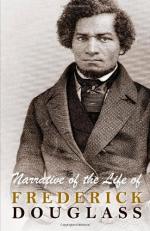|
|
The Narrative of the Life of Frederick Douglass Notes & Analysis
The free The Narrative of the Life of Frederick Douglass notes include comprehensive information and analysis to help you understand the book. These free notes consist of about 43 pages (12,822 words) and contain the following sections:
These free notes also contain Quotes and Themes & Topics on The Narrative of the Life of Frederick Douglass by Frederick Douglass.
The Narrative of the Life of Frederick Douglass Plot Summary
Frederick Douglass begins his narrative with his birth in Talbot county, Maryland. He estimates that at the time of his writing, in the early 1840's, he is twenty-seven or twenty-eight years old. Little is known about the facts of his childhood. He remembers having met his mother a few times. Rumor has it that his father was a white man, possibly his master, Captain Anthony. At a young age, Douglass goes to live at the Great House Farm, the home plantation of Colonel Lloyd who is a rich landowner in Talbot county. Growing up at the Great House Farm, Douglass experiences the harshness of slavery. He is constantly cold and hungry. He even witnesses Captain Anthony whipping his Aunt Hester until she is bloodied. In Talbot county, a slave has no rights. In one instance, Mr. Austin Gore, the overseer of the Great House Farm, shoots a slave in cold-blood for refusing to obey his orders. His explanation that slavery will end if even one slave gets away with disobedience is accepted and he faces no punishment. There are many cases like these in Talbot county.
At the age of seven or eight, Douglass is sent to live with Mr. and Mrs. Hugh Auld in Baltimore. Douglass regards his move to Baltimore as the first major step toward freedom. At first, Mrs. Sophia Auld is generous and kind. But when Mr. Auld rebukes her for attempting to teach Douglass how to read, she becomes a different person. Slavery turns her from an angelic person to a cruel, bitter slaveholder. Because of Mr. Auld's condemnation of reading, Douglass sets upon the task of learning how to read. He succeeds by asking the white kids around the neighborhood. At around twelve years of age, Douglass reads The Columbian Orator, a book about ideas such as liberty, justice, and truth. In reading the book, Douglass realizes that knowledge brings forth both enlightenment and misery. Douglass makes the decision that someday he will attempt to escape to his freedom. Thinking that he might have to write his own pass one day, he teaches himself how to write. When Captain Anthony dies, Douglass returns to Talbot County to be evaluated for the division of property. Douglass is sent back to Baltimore but two years later, Mr. Hugh Auld has a falling out with his brother, Thomas Auld, and Douglass is sent back to live with his old master.
Having lived in the city, life in the country with Captain Thomas Auld is difficult for Douglass. Furthermore, Captain Auld finds religion and Douglass sees him as a religious hypocrite. Captain Auld, on the other hand, believes that city life has spoiled Douglass and has made him unfit to be a slave. To have him broken, Captain Auld sends Douglass to work for Mr. Edward Covey, a farm renter with a reputation for being a "nigger breaker." The first six months working for Mr. Covey is the darkest time of Douglass's life. He is overworked and constantly beaten. One day, after getting beaten badly by Mr. Covey, Douglass tries to get help from Master Thomas. When that fails, he decides to fight back or die trying. After a two-hour duel with Mr. Covey, Douglass comes out with the conviction that anyone who attempts to beat him again will face retaliation. After the fight, Mr. Covey does not touch him again. After working for Mr. Covey, Douglass is sent to work for Mr. Freeland. Douglass finds him to be a fair and respectable master. After a year, Douglass rounds up a group of slaves who are willing to escape with him. But on the day of their planned departure, they are betrayed and eventually caught and thrown in jail. The others are soon released, but Douglass, having been the mastermind of the escape, is held longer. Captain Auld takes him home and sends him again to Baltimore.
In Baltimore, Douglass is sent to a shipyard to learn how to calk. The first shipyard that he goes to, he ends up in a fight with some of the white workers. Badly beaten, Douglass is sent to another shipyard. Finally, he learns to calk and begins earning good money. He convinces Mr. Hugh Auld to allow him to hire out his time, meanwhile planning his escape. On September 3, 1838, Douglass succeeds in reaching New York-finally a free man. Through the help of abolitionists, he is able to settle in New Bedford, Massachusetts with his wife, Anna. As a free man, Douglass involves himself in the abolitionist movement, eventually becoming one of the most influential speakers against slavery in American history.




